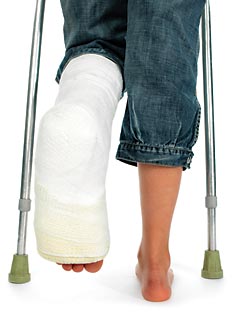So you’re talked with your orthopaedic surgeon
and they have said you’ll need to be non-weight bearing for a period of weeks after your surgery. What does non-weight bearing really mean, and what options do you have for getting around?
The term non-weight bearing refers to restrictions placed on you immediately after surgery. This means that you are not to put the surgically repaired foot on the floor with any weight whatsoever, not even for a second or two whether standing or seated.
Why is touching the ground so bad after foot or ankle surgery?

Typically it is very hard for most people to accurately gauge how much
weight they’re putting on a foot even if they’re just grazing the floor with it. Putting any weight on an operated foot or ankle can do damage to the repair that’s been done. Bones need time to heal. Plates or screws that may have been added during surgery need the bones to heal around them. Adding weight too soon can interrupt this important internal healing process.
All procedures that involve surgical cutting benefit from a period of no weight, this helps by not aggravating the area and keeps swelling to a minimum which will help tissues heal more quickly, keeping the foot elevated will also help control pain.
How can I getting around and be non weight bearing?
If your surgeon has said that avoiding any weight on your foot is essential to healing, there are several options available for maintaining mobility.
Crutches. Many patients use crutches after surgery to keep their affected foot off the ground. The most common type of crutches, are made of wood or aluminum and fit under the arms. Adjustment is important. You should be able to fit two fingers under your arm when standing with crutches. With your arms hanging down, the crutch handle should be at the crease of your wrist. For some patients, a standard walker may also be useful.
Walkers. Come in a variety of styles either 4 post, slide or wheel, these help you move about in a more stable way and are preferred by people who may not have the strength or confidence to use crutches. Walkers also make a stable platform to help in and out of bed and on and off the toilet.
Wheel Chair. Allowing you to roll about in a seated position using your own power, though some models come in powered versions. Accessories such as a leg lift can be add to keep your leg elevated. Wheel chairs can be rented or purchased.
All of these items are available to either hire or buy, if you would like a starting point in trying to find hire companies in your state then check out our Home Aids page.
Following your surgeon’s orders, especially when it comes to staying off of your operated foot, can make the difference between a normal healing period or a longer healing period with potential complications. Before your surgery, make sure you understand your surgeon’s non-weight bearing instructions, particularly the length of time you’ll need to avoid weight on your foot. And then plan ways to stay mobile during this time.
